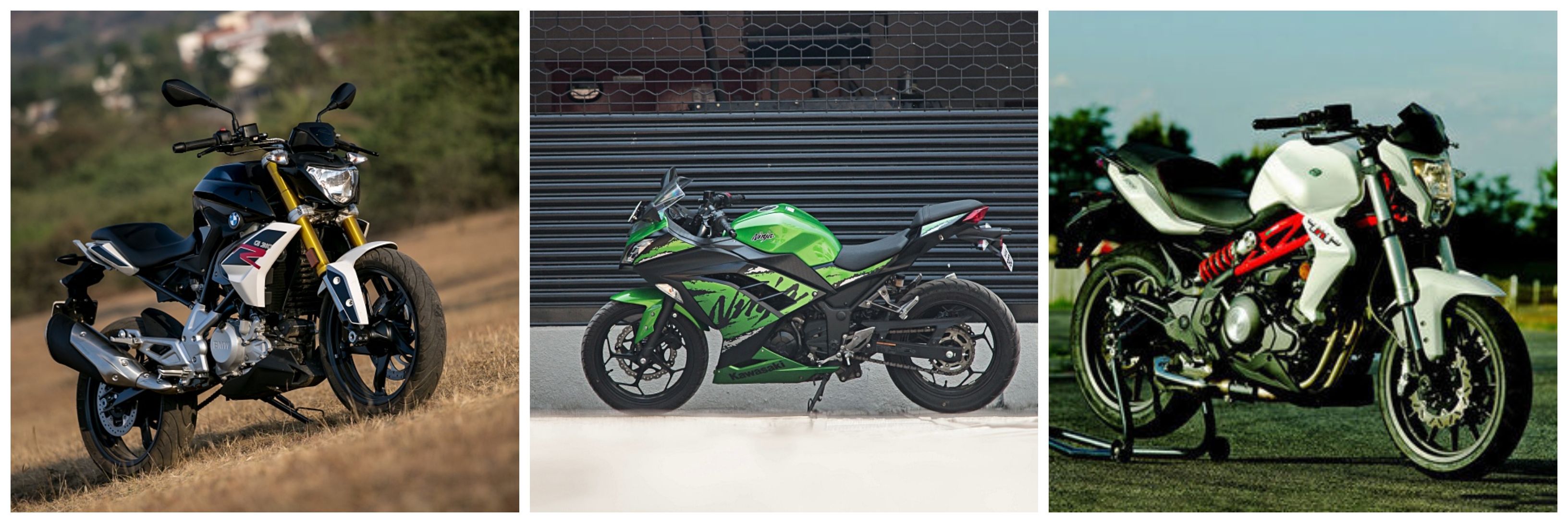Kawasaki Ninja 300 vs BMW G 310 R vs Benelli TNT 300: Real World Comparison
Modified On Apr 6, 2019 10:28 AM By Niraj Kakade for Kawasaki Ninja 300
- 2578 Views
- Write a comment
Which has the most potential to dare our Indian roads and traffic - the Japanese, the Italian or the German?

Indian buyers are now spoilt for choices when it comes to 200cc to 300cc entry-level performance machines. If you happen to be one of them and don’t want something as aggressive as the KTM 390 Duke, you’re left with three popular choices: Kawasaki Ninja 300, BMW G 310 R and the Benelli TNT 300. You also do have the likes of the Yamaha YZF-R3 or the Ninja 400, but these two are sure to burn deep holes in your pocket. We have not ridden the Honda CB300R yet, so it has to be left out of this comparo. Hence, we’ve compared the real-world numbers of the contenders from Germany, Italy (China) and the green side of Japan to see which makes a better case on paper for itself.
Acceleration
|
Kawasaki Ninja 300 |
BMW G 310 R |
Benelli TNT 300 |
|
|
0-60kmph |
3.36 seconds |
3.07 seconds |
3.51 seconds |
|
0-100kmph |
7.17 seconds |
7.47 seconds |
8.20 seconds |

Off the line, the BMW G 310 R leaps quicker and further than the Ninja and the Benelli thanks to its comparatively low weight. However, go higher up the revs and the Ninja’s parallel twin comes into its strides, reaching triple-digit speeds faster than anyone. It will zoom past the baby Beemer post 100kmph. While the Benelli too packs a parallel-twin engine layout and a healthy 39PS of power, its heavy (196kg) weight makes it the slowest of the lot.
Roll-ons
|
Kawasaki Ninja 300 |
BMW G 310 R |
Benelli TNT 300 |
|
|
30-70kmph |
4.13 seconds |
3.53 seconds |
4.63 seconds |
|
40-80kmph |
5.05 seconds |
4.51 seconds |
5.51 seconds |

Here’s where the BMW G 310 R shines as an urban commuter. While all three motorcycles pack almost similar torque figures (G 310 R - 28 Nm at 7,500 rpm, Ninja 300 - 27.0 Nm at 10,000 rpm and TNT 300 - 26.5 Nm at 10,000 RPM), it is with the little BMW that you’ll find swift overtakes the easiest. Also helps that it is the lightest of the three. You can see that on both twin-cylinder motorcycles in question here, the peak torque is made really higher up the rev range. The Ninja’s quicker engine revving helps it achieve better roll-on timings.
Braking
|
Kawasaki Ninja 300 |
BMW G 310 R |
Benelli TNT 300 |
|
|
100kmph-0 |
51.32m |
50.61m |
52.86m |
|
60kmph-0 |
17.83m |
18.78m |
18.51m |

Although the BMW G 310 R pack the biggest braking hardware here (front 300mm single disc, rear - 240mm single disc), the Kawasaki Ninja 300 ABS is more effective in shedding speed in short distances. This despite it being almost 20kg heavier than the G 310 R. The new localised parts, such as the Endurance brakes and the MRF rubber, have helped in achieving this phenomenal stopping power. The TNT 300’s brakes, on the other hand, feel rather poor in comparison. It also doesn’t help that the bike itself weighs close to 200kg (kerb - 196kg to be precise).
Fuel Efficiency
|
Kawasaki Ninja 300 |
BMW G 310 R |
Benelli TNT 300 |
|
|
City |
32.1kmpl |
37kmpl |
33.75kmpl |
|
Highway |
31.10kmpl |
31.86kmpl |
31.94kmpl |

Coming to the most important question here - kitna deti hain? Well, if your commute involves hitting the highway quite often, all three motorcycles will give you a similar range of numbers. But it is the Ninja 300 you want to be on, with its almost-vibe-free engine and a generous 17-litre fuel tank. In the city, though, the G 310 R proves to be the better companion. Yes, it does pack a small 11-litre fuel tank, but it's also the most frugal in urban conditions by a good margin.
